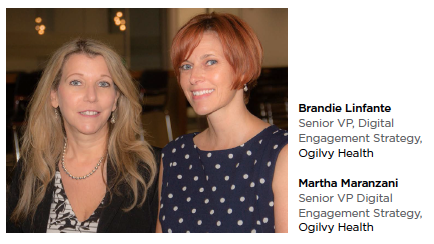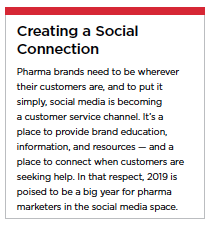 In a relatively short period of time, social media has reshaped communication for consumers and healthcare professionals alike. No longer are users simply posting content and communicating amongst themselves — social channels are now dominated by media reaching specifically targeted audiences.
In a relatively short period of time, social media has reshaped communication for consumers and healthcare professionals alike. No longer are users simply posting content and communicating amongst themselves — social channels are now dominated by media reaching specifically targeted audiences.
Looking forward to what lies ahead in the social space, we have compiled the top social media trends for pharma in 2019 based on innovation, growth, and opportunities for pharma.
In 2018, pharma companies dipped their toes into the waters of social media with paid ads and dark posts, beginning to embrace and relate to their audiences through the social medium. 2019 will be the year that they dive in, feet-first, cannonball-style, connecting with their audiences in ways they wouldn’t have considered in years past. Read on to find out how pharma companies can benefit from using social media in the year ahead.
Ephemeral Content
Google has coined the term “micro-moment" to describe those points in time when users reflexively turn to their mobile devices — usually smartphones — to learn something, do something, find something, or watch something. During these micro-moments, consumers make instant decisions and form preferences based on the information served up at that precise moment in time. Marketers will increasingly take advantage of these moments that matter by serving up the right information exactly when users need it.
The message to pharma marketers about these micro-moments? Users don’t care about your brand story first, they care about their own informational needs. Give them what they need in that brief moment in time, and plan a strategy to intercept and engage with them at other moments in their patient or HCP journeys when they are searching for information to lay out your brand story. Capturing users in these micro-moments will be key for pharma marketers in 2019.
Authenticity
Consumers are increasingly distrusting of advertising and marketing. Younger consumers, especially millennials, choose brands from companies that share their same values. This was confirmed in Cohn & Wolfe’s 2017 Authentic Brand Study, which showed that 91% of consumers are willing to reward a brand for authenticity. In 2019, pharma brands will come out on top if they are transparent in their social media marketing strategies and the content that they produce. Social content such as influencer marketing, partnerships with advocacy, and cause marketing will be the content that actually matters to consumers and will make pharma brands relevant to them. Bottom line: authenticity always wins the day.
User-Generated Content
Leveraging user-generated content (UGC) is one way in which pharma marketers will increase their authenticity on social media in 2019. UGC is the new word-of-mouth, and pharma brands can demonstrate a presence that is genuine and credible by repurposing UCG created by their consumers.
Influencer marketing will continue to grow as well, and pharma marketers can create UGC at scale by using social media influencers. Influencers are an extension of the brand, and if they are authentic then the brand will be seen as more credible through a halo effect. Patient education and advocacy programs are two areas that will benefit greatly from influencer marketing campaigns in 2019.
Chatbots
Emarketer estimates that nearly 2.19 billion consumers will be using messaging apps or bots by the end of 2019, making chatbots a no-brainer for pharma companies to reach their consumers in real time.
Consumers like using chatbots because they are personalized, responsive, and provide immediate answers, letting them find the information they are searching for quickly. Chatbots can be leveraged across not only messaging apps such as Facebook, but also a brand’s website, SMS, in a voice skill (Alexa/Google Home), and they can be the bridge to bringing consumers or HCPs into a wider CRM stream. Additionally, they can be the first line of customer service, funneling users to humans when necessary and helping keep call center costs down by answering the same questions repeatedly, freeing up customer service representatives to be able to provide better service to customers requiring additional assistance. Pharma companies will start leveraging chatbots on a larger scale in the year ahead.
Smart Speakers and Voice Technology
Voice technology adoption is on the rise, outpacing even the rate at which cell phones were adopted.
ComScore predicts that by the end of 2020, 50% of searches will be voice searches through “conversations" with voice assistants. Additionally, apps like WonderVoice allow users to post to their social apps and read their social feeds. So that means that in 2019, pharma marketers need to optimize their SEO (search engine optimization) for voice, not just on search engines, but in social search and social feeds as well. Furthermore, by layering a voice strategy on top of chatbots, pharma brands have the opportunity to provide customer service in an entirely new way that is more humanized and personalized than the typical “press 1 to speak to a customer service representative" call center decision tree. Expect more voice chatbot customer service representatives to show up in pharma in 2019.
eCommerce and Integrated Services
70% of Instagram users use their mobile devices to purchase online, and it is now even possible to purchase directly through Instagram. While prescription pharma brands can’t directly market to users in this way, it shows that consumers are primed for ecommerce opportunities. And with Amazon’s purchase of PillPack and their partnerships with health data providers and health systems, the potential definitely exists for pharma ecommerce opportunities. As for other integrated services, in 2019 social media will  increasingly be leveraged for consumers to sign up for patient assistance programs and for HCPs to enter CRM streams and order samples through channels such as Facebook’s lead generation ads. Since consumers use these social channels more often than visiting a brand website, pharma marketers will increasingly find their users and initiate CRM programs through social media as well.
increasingly be leveraged for consumers to sign up for patient assistance programs and for HCPs to enter CRM streams and order samples through channels such as Facebook’s lead generation ads. Since consumers use these social channels more often than visiting a brand website, pharma marketers will increasingly find their users and initiate CRM programs through social media as well.
AR and VR
Augmented reality (AR), virtual reality (VR), and mixed reality technologies will evolve social media interactions in 2019. AR takes content from two dimensions to 3D, and users create their own content experiences with virtual content (think Snapchat). VR provides the opportunity to create different worlds and immersive experiences, and several social communities are already hooked on VR technology.
Pharma marketers who embrace these technologies and create interactive experiences for their audiences in 2019 will come out on top. However, using technology for technology’s sake isn’t the best course of action, and brands should only choose these immersive technologies if they can answer a content need for their audience. Seeing more AR, VR, and mixed reality experiences is a sure bet for 2019.
Live Streaming
Live streaming will continue to gain traction across social media in 2019 since it adds a different dimension to posts, bringing an experience to life in real time. Live streaming will become easier for brands to produce and share, and live stream aggregators will allow consumers to find and keep track of events they find interesting. One key factor here will be bringing the ideas to regulatory committees proactively, and making it clear that live events can be developed with pre-approved content. Savvy pharma marketers will leverage live streaming in social in 2019 for HCPs and consumers alike for events such as product launches, release of new data, new product indications, and conference coverage.
Social TV
Social isn’t just an outlet for reaching friends or connecting with colleagues anymore, as the largest social networks are hosting and purchasing rights to major TV programming. Already, Twitter live streams sports events and news, and the wider social TV market is only expected to keep growing. Pharma marketers will use social media TV networks to enhance programmatic customer engagement and extend their traditional marketing campaigns and promotions across social TV. Brands will find multiple opportunities in the space to both advertise and create brand channels in the coming year.
Global Growth
The total number of social media users worldwide is poised to grow from 2.62 billion in 2018 to 3.02 billion in 2021 according to Statista. The increased usage of mobile devices and smartphones worldwide has opened up the opportunity for pharma marketers to reach their consumers across the globe. Social media itself is becoming more global as influencer content is changing the way brands reach their consumers. While the current blockbuster social channels will continue to prevail, new channels will start to emerge and become more visible on a global scale. There will be more niche social media networks coming to the forefront gaining market share. By staying current with their consumers and which social channels they use, pharma marketers can intercept their consumers and provide them with useful content as they go about their everyday lives, wherever they are across the globe.
Looking to the Future
Pharma brands need to be wherever their customers are, and to put it simply, social media is becoming a customer service channel. It’s a place to provide brand education, information, and resources – and a place to connect when customers are seeking help. In that respect, 2019 is poised to be a big year for pharma marketers in the social media space. The trends outlined here can accelerate brands and their ability to reach their customers in new and engaging ways, modernizing and changing the way they provide value and market to consumers and healthcare professionals alike.(PV)
Ogilvy Health is committed to creativity and effectiveness in healthcare communications, everywhere.
For more information, visit ogilvychww.com.


















